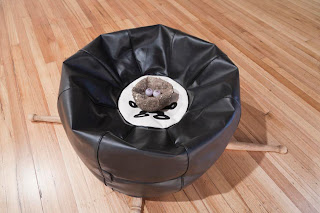Michaela Gleave’s Cloud House in the Octopus 11 – The Matter of Air exhibition at Gertrude Contemporary creates a magic space, even with all the parts of its construction exposed. The walls of the gallery are painted Yves Klein blue. Two smoke machines pump smoke into a cubby-like house through little windows. The viewer must climb a ladder to get inside. The smoke fills the floor of the house to create an illusion of infinite depth.
The clear and logical transparency of how the work is made only enhances the fun. It evokes the smoke and mirrors illusions of a magic show and, thus, the desire of an imaginative audience to suspend the disbelief. It must be heartbreaking for magicians when their audience gets to an age when they only care about how the magic is done and feel annoyed at having been ‘tricked’ as youngsters. Gleave in no way tries to trick us. This is important because it means we can leave our 10 year old cynic down the bottom of the ladder to ponder the smoke machines. We can then feel free to just enjoy the enchantment of the Cloud House.
The work combines a childhood place of play with the desire to escape the reality of logic and function. Like in Narnia, the Magic Faraway Tree or the Harry Potter series, the work reminds us of our desire for secret doorways to open up for us into a world where we can defy the rules of science, caution and expectations. These worlds, like dreams or imaginative child play, offer characters in fiction the opportunity to work through the tensions and anxieties that underpin life in the ‘real world’. The suggestion of infinite depth and magic contained in this cubby house feels akin to the depths of the imagination in a space where one can play without being self-conscious.
I didn’t realise I could get into the cubby even though I really wanted to. I stood and watched the smoky room from the ladder. Perhaps it was the blinding clean whiteness that inhibited me or a sense of depth created by the smoke that I read as something I would sink into. I now feel like I missed out on an chance to experience something I have fantasised about when staring out plane windows or lying back on picnic rugs. Maybe it was my understanding of clouds as something that you would fall through if you tried to sit on them like they were white fluffy cushions that stopped my ability to reason that this space was open to me to step into. The enclosed cubby house should have logically reassured me. But notions of the owners of cubbies being notoriously territorial could also have been putting me off. The otherworldliness of such a cubby maybe also told me that this space was not for me. It was like where cherubs might go to barter celestial swap cards.
Gleave’s work reminds me of one of the first installations I ever went to - Asher Bilu's Escape 1992. In Luba Bilu's gallery in Greville Street, Prahran, in a large dark room, there were piles and piles of white shredded paper that were lit by neon lights. Every afternoon school students like me from all over the south east would dump their school bags at the door of the gallery to romp around in the shredded paper and enjoy the utter delight of entering a secret, magic place. Artworks like Cloud House will let your mind play in them like you were once able to do with a box or a tree as a child. Even if you don't step in.
Anna
Anna












